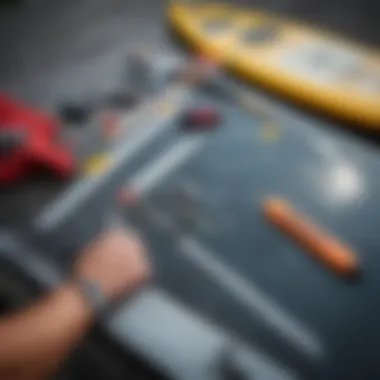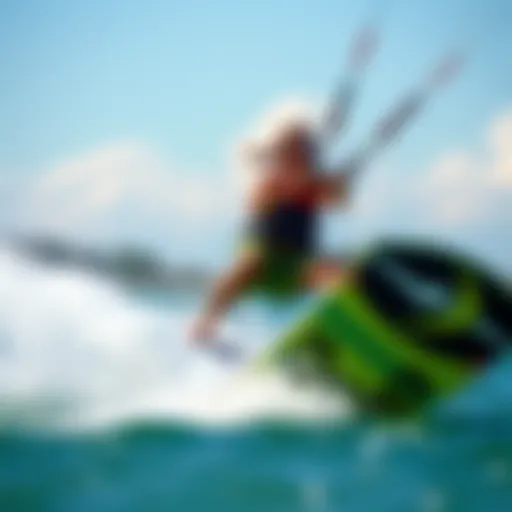A Complete Guide to SUP Hydrofoils: Buying Tips and Insights


Intro
Diving into the world of stand-up paddleboard (SUP) hydrofoils is akin to exploring a new frontier in water sports. Not too long ago, these specialized watercraft were veiled in uncertainty, primarily known only to a niche group of enthusiasts. However, as more adventurers seek to lift above the water’s surface, the market for hydrofoils has expanded, presenting a realm of choices that might leave even seasoned paddlers scratching their heads.
The essence of this guide is to illuminate the complexities of purchasing a hydrofoil, allowing you to navigate with clarity and purpose. Whether you're a seasoned pro with a nose for the latest tech, or a newcomer eager to break into the sport, understanding hydrofoils is vital. The article will dissect various aspects, from the types of hydrofoils available to considerations when buying. Moreover, we'll shine a light on the technological advancements that have taken SUP riding to new heights literally.
It's important to remember that hydrofoiling is not merely about the gear; it’s an experience supported by technique, safety, and, of course, a bit of adventure spirit. Let's take that plunge and explore the essentials of this exhilarating sport.
Understanding SUP Hydrofoils
SUP hydrofoils represent a fascinating and evolving segment in the realm of water sports. For paddleboard enthusiasts, grasping an understanding of hydrofoils is essential. They not only enhance the performance of a standard SUP but also introduce a unique riding experience that combines elements of surfing and flying over water. This section aims to unpack the significance of hydrofoils in the world of stand-up paddleboarding, addressing what they are, how they function, and their historical journey.
What is a SUP Hydrofoil?
A SUP hydrofoil is a specialized attachment that elevates a paddleboard above the water’s surface, essentially allowing the rider to glide as if they are flying. Picture a small wing-like structure connected beneath the board that generates lift as the rider paddles forward. As the board picks up speed, the hydrofoil lifts it, reducing drag and enabling smoother navigation through water. Riders often describe the sensation as akin to floating on air.
How Hydrofoils Work
Understanding how hydrofoils work is crucial for anyone considering one for their paddleboarding adventures. The mechanics can be broken down into a simple principle: lift and drag.
- As the board accelerates, the hydrofoil's shape directs water flow underneath it, creating an upward force. This is the lift.
- The more speed, the greater the lift, and eventually, the board rises.
- Once the board is elevated, drag is significantly reduced, allowing for a more efficient glide.
This phenomenon lets paddlers glide across flat water and even handle light chop with ease. In essence, hydrofoils allow for a greater versatility in water conditions, opening new possibilities for exploration and enjoyment.
History and Evolution of Hydrofoiling
The journey of hydrofoiling isn’t something that sprung into existence overnight. It has a rich history dating back to the early 20th century, with its roots primarily in aeronautics. The initial concept was developed by inventors who aimed to create faster boats. Over time, this technology adapted to various water sports, including surfing.
By the late 1950s, hydrofoils began to appear in recreational boating. However, it wasn’t until the 2000s that they emerged on SUPs. This boom introduced riders to a new way of experiencing water sports.
The integration of lightweight materials such as carbon fiber and advances in design have significantly enhanced performance, making modern hydrofoils more accessible to recreational users.
In summary, the understanding of SUP hydrofoils encompasses their definition, mechanization, and historical context. For potential buyers and enthusiasts alike, comprehending these elements is vital to maximizing your paddleboarding experience.
Hydrofoils offer a unique experience that merges the thrill of surfing with the smoothness of flying—truly a game-changer in the world of water sports.
Key Features to Consider
When diving into the world of SUP hydrofoils, understanding key features is crucial. These factors significantly influence your overall experience and performance on the water. As the sport gains traction, the variety of options can feel overwhelming. But zeroing in on specific elements will streamline your buying process and enhance your enjoyment of hydrofoiling.
Size and Shape of the Hydrofoil
The size and shape of a hydrofoil plays a vital role in its performance. Typically, a larger foil surface area gives you more lift at lower speeds, which makes it easier for beginners to get off the water. Conversely, smaller foils are usually designed for speed, providing less drag and allowing more advanced riders to excel in high-speed conditions. The overall shape also impacts maneuverability. A more rounded shape can increase stability, while a pointed design promotes agility. Riders should consider their skill level, preferred riding style, and local conditions when choosing the right size and shape.
Material Considerations
Hydrofoils are constructed from various materials, each offering distinct advantages. Most foils are made from either aluminum, carbon fiber, or composite materials. Aluminum is durable but heavier. Carbon fiber, while lighter and stiffer, tends to be pricier. The choice of material affects the hydrofoil's weight, performance, and durability, making it essential to decide based on one's budget and desired riding style.
Weight Capacity and Stability
Achieving stability is a fundamental consideration when selecting a hydrofoil. Each model has a specific weight capacity, which indicates how much load it can handle efficiently. A hydrofoil with a higher weight capacity often translates to greater stability on the water. It's crucial for riders to choose a foil that accommodates their body weight and any additional gear they might take onboard. Riders looking to skate smoothly above the surface should prioritize stability to boost their confidence and control, especially for those still in the learning phase.
Foil Design Types
The design of hydfoils can be categorized into three main types, each catering to different preferences and riding styles.
Rigid Foils


Rigid foils are specifically engineered for stability and performance at high speeds. One key characteristic of these foils is their structure, which maintains a fixed shape, ensuring consistency on the water. For experienced riders looking to tackle challenging waves or perform tricks, rigid foils can be particularly beneficial. However, they may be less forgiving for beginners, making them a choice best suited for those with solid skills.
Flexible Foils
Conversely, flexible foils are known for their adaptability to various conditions. With a design that can flex under load, these foils can absorb shock and provide smoother rides even when the water gets choppy. This flexibility can lead to an enhanced feel while riding, giving users a sense of connection to the water. However, they might lack the precise control at high speeds compared to their rigid counterparts. Thus, for riders who prioritize comfort over speed, flexible foils could be highly advantageous.
Adjustable Foils
Finally, adjustable foils offer the most versatility. These foils allow riders to change specific aspects such as the wing size or angle, adapting their setup to match their evolving skills or changing conditions. This particular characteristic can be a game-changer for those who enjoy experimenting with different riding styles. On the flip side, the complexity of adjustment can be daunting for novices. Careful consideration is needed whether this adjustable feature aligns with one's riding ambitions or is merely an added complexity.
Selecting the right hydrofoil involves factoring in these components to ensure a tailored experience. Whether you prioritize speed, flexibility, or adjustability, understanding these facets will provide a solid foundation as you embark on your hydrofoiling journey.
Popular SUP Hydrofoils on the Market
When it comes to choosing the right SUP hydrofoil, knowing which brands stand out is critical. This section not only digs into the top players in the market but also extends the understanding of how these products enhance the experience for users ranging from beginners to seasoned paddlers. Evaluating popular SUP hydrofoils helps determine factors, such as performance features and user preferences, which play a vital role in making an informed purchasing decision.
Top Brands Overview
Brand A
Brand A has carved a significant niche in the hydrofoil market by focusing on robust design and performance. They emphasize durability and ease of use, making it an attractive choice for novices and experts alike. One key characteristic that sets Brand A apart is its lightweight construction, aimed at improving the rider's experience on the water.
The unique feature of Brand A is its patented foil shape that reduces drag, allowing paddlers to achieve impressive speeds while maintaining stability. This makes it particularly beneficial for those who want to master various moves on the water.
However, some might find that even with its advantages, it may come at a higher price point. It's often regarded as a premium option, which could be a dealbreaker for budget-conscious shoppers.
Brand B
Brand B is well-known for its innovative approach to hydrofoil design, incorporating advanced technology that appeals to tech-savvy paddlers. One standout quality of Brand B is its adjustable foil systems, enabling users to customize their riding experience based on conditions and skill level.
A unique aspect of Brand B is their emphasis on eco-friendly materials. This not only caters to the growing market for sustainable products but also creates a compelling argument for environmentally-conscious buyers. Brand B’s products, while generally effective, may have a steeper learning curve compared to other brands, which can be daunting for complete beginners.
Brand
Brand C has built a reputation for affordability without skimping on quality. It often acts as a go-to choice for entry-level customers looking to dip their toes in hydrofoiling. The key aspect of Brand C is the user-friendly design that simplifies the process of getting on the water, making it accessible for those just starting.
What sets Brand C apart is its strong community of users and online support, along with numerous resources available for skill development. This factor can be invaluable for someone inexperienced in hydrofoiling. Still, users should be mindful that the lower price point may come with compromises in terms of performance and durability, particularly under more challenging conditions.
Comparative Analysis of Models
After identifying key brands, proceeding with a comparative analysis of various models brings clarity to potential buyers. Factors include performance, ease of use, and intended applications. For example, if someone leans towards a more aggressive riding style, understanding the specific models offered by each brand could illuminate which hydrofoils best suit high-speed riding versus casual gliding.
User Reviews and Feedback
Finally, user reviews serve as practical insights from fellow paddlers. Sites like Reddit or dedicated paddling forums often feature real-world experiences that illuminate the pros and cons of different SUP hydrofoils. Such detailed feedback becomes crucial when deciding which hydrofoil aligns best with personal preferences or specific riding conditions. These first-hand accounts can sway purchasing decisions based on usability and performance.
Purchasing Considerations
When it comes to investing in a SUP hydrofoil, understanding the purchasing landscape is vital. The choices you make can significantly affect your experience on the water, from performance to maintenance, and even your budget. Knowing where to buy, whether to opt for new or used, and being aware of warranty approaches are all crucial elements.
Where to Buy SUP Hydrofoils
Retail Stores
Visiting a retail store can be an experience in itself. Often, these locations have a plethora of options for you to physically inspect. You can touch the materials and even get a feel for the weight of different hydrofoils. This tactile experience is something online shopping simply can't replicate.


A key characteristic of retail stores is the immediate availability of products. You find what you want, pay for it, and head right to the water with it. However, the downside is that prices can be higher due to the overheads of physical operations.
Additionally, knowledgeable staff are often a feature of these shops. They can offer insights into models and might even let you try out demo units, a unique advantage for achieving a better understanding of your options.
Online Marketplaces
In today’s digital age, online marketplaces are quite the trend. Websites like Amazon and eBay provide an extensive range of SUP hydrofoils. The convenience factor is a standout feature here; you can search, compare prices, and read countless reviews—all from the comfort of your home.
However, quality control can sometimes become an issue, as it might be tricky to discern the credibility of sellers. Plus, waiting for shipping can feel like watching paint dry, especially when you're eager to hit the waves. Also, the return policies can vary widely, making it essential to read the fine print carefully before purchasing.
Specialty Shops
Specialty shops are like a hidden gem in the retail landscape. These destinations cater specifically to water sports enthusiasts. They often stock high-performance gear and the latest technology. If you’re seeking expert advice, this is the place to be.
One of the unique features of specialty shops is their sense of community. You might meet fellow adventurers who can share tips or even recommend gear. While prices might be on the higher side compared to large retailers, the quality of service and products you can receive often justifies the cost.
New vs. Used Hydrofoils
Buying new hydrofoils means you often have the latest technology and optimal performance in your hands. However, it can strain your wallet. On the flip side, diving into the second-hand market could save you a bundle. Many used SUP hydrofoils are in astonishingly good condition and perform well.
When purchasing used, it’s crucial to thoroughly inspect for any signs of wear or damage. Just because the price is attractive doesn’t mean it’s a steal.
Warranty and Return Policies
A solid warranty can be a lifesaver. When you opt for a new hydrofoil, look for brands that offer robust warranties. This adds peace of mind, as you know that in case something goes awry, you have recourse. Return policies are just as essential. Make sure to check how long you can return the product, and whether you can get a refund or store credit. If you have to deal with a faulty product, knowing that you can return it without hassle is a game changer.
In summary, being mindful of where to buy, considering new versus used, and understanding warranties can make all the difference in your SUP hydrofoil experience.
Getting these aspects right can not only enhance your purchasing decision but also lay a solid foundation for your fun and adventure on the water.
Performance and Experience Enhancement
When it comes to SUP hydrofoils, performance and experience enhancement are at the heart of what attracts both experienced riders and novices. Hydrofoiling offers an exhilarating experience, transforming how we interact with water. Unlike traditional paddleboarding, these advanced watercraft allow a rider to lift above the surface, harnessing the power of winds and waves in unusual ways. This section delves into the key motivations that underline the benefits and skills connected to using hydrofoils.
Benefits of Using a Hydrofoil
Hydrofoils provide a unique set of advantages that distinctly enhance one’s paddling experience. For starters, there’s the sheer joy of gliding above the water's surface. This elevation reduces drag, allowing for faster speeds with less effort. Thus, long-distance paddling becomes much more attainable. For those looking to engage in a bit of a workout, hydrofoils challenge muscles differently, providing opportunities for strength and balance training.
Furthermore, you can often enjoy your time on the water even in less than ideal conditions. As hydrofoils lift the board above the choppy water, they enable smoother rides in rougher seas. Experienced paddlers can easily transition from flat water to waves without missing a beat.
Of course, there are performance aspects to consider. Speed is a major benefit but so is maneuverability. Hydrofoils can turn sharper and react more swiftly, catering to adventurous spirits looking for dynamic rides. Overall, using a hydrofoil may lead to better control, and that opens up a world of thrilling opportunities.
"Hydrofoiling not only changes how you paddle but how you perceive the power of the water."
Tips for Improving Hydrofoil Skills
To truly master hydrofoiling, a few various strategies can be implemented, and one’s approach can make all the difference in skill development. Here are some targeted tips for improving your hydrofoil skills:
- Start Small: Begin on flat water and gradually move to more challenging environments. Getting comfortable first allows you to build confidence.
- Focus on Body Positioning: Keeping your body low and centered helps maintain balance. Lean slightly forward to keep the foil engaged with the water.
- Practice Foot Positioning: Adjusting your foot placement can profoundly affect your balance and maneuverability. Experiment until you find what feels right.
- Use the Right Gear: Make sure your hydrofoil is well-suited for your skill level. Some foils are designed for beginners, while others cater to advanced users.
- Consider Video Feedback: Recording your sessions can provide insights into how you can improve. See the finer details of your technique that might be easily missed in the thrill of the moment.
- Join a Community: Engaging with forums or groups on platforms like Reddit or Facebook can lead to invaluable tips and advice from experienced riders. High-level conversations can often bring new perspectives.
By placing emphasis on skill development, hydrofoilers can greatly enhance their overall experience and performance. Each ride can transform from a simple paddle session into an exciting adventure filled with potential.
Maintenance and Care for SUP Hydrofoils
Taking proper care of your SUP hydrofoil is not just about keeping it looking good; it's about ensuring optimal performance and longevity. A single maintenance oversight can have a ripple effect, impacting everything from how well the foil operates to how safe you are on the water. Understanding maintenance practices can fortify your investment and enhance your riding experience.


Regular Maintenance Practices
Regular maintenance is your best friend when it comes to hydrofoils. Some might think a quick rinse is enough after a day on the water, but there's more to it. Here’s a quick rundown of practices you shouldn’t overlook:
- Rinse With Fresh Water: After every use, make a habit of rinsing your hydrofoil with clean water. Saltwater or sand can be particularly harsh on the components, leading to corrosion or wear.
- Inspect for Damage: Regularly check for any visible cracks or dents on the foil and board. A small crack might seem insignificant, but it can worsen over time, costing you more down the line.
- Dry Thoroughly: Water can be a friend but also a foe. Be sure to dry your hydrofoil completely. Use a soft cloth to soak up moisture before storing. This simple step reduces chances of mildew, especially on fabric components, if applicable.
- Check the Fittings: Ensure that all screws and attachments are tight. Vibration and use can cause them to loosen over time. A quick check can save you from potential accidents or damage later.
Storage Guidelines
Storing your hydrofoil correctly is equally important. A careless approach to storage can lead to damages that might not be immediately visible. Here are some essential storage guidelines to help you maintain your hydrofoil's longevity:
- Climate Control: If possible, store your hydrofoil in a climate-controlled environment. Extreme temperatures, especially high heat, can warp the materials used in the construction.
- Avoid Direct Sunlight: UV rays can cause discoloration and deterioration of the hydrofoil's materials. When not in use, consider covering your hydrofoil or storing it in a shaded area.
- Use Soft Padded Bags: Transport and store your hydrofoil in padded bags designed for this purpose. They provide cushioning against impacts and prevent scratches, which could complicate hydrodynamics when you’re out on the water.
- Store High Off the Ground: If you’re storing your hydrofoil in a garage or shed, keep it off the ground. Storing it up high prevents moisture from pooling beneath it and reduces risks from pests.
Common Issues and Solutions
Even with the best care, issues can pop up, and being prepared with solutions can save you time and headaches. Here’s a list of common problems faced by hydrofoil enthusiasts and how to tackle them:
- Rust on the Fittings: If you're using a foil with metal components, rust can be a real problem. To combat this, regularly wipe metal parts with a corrosion-inhibiting lubricant.
- Dings and Dents: Accidents happen, and your foil might experience bumps and bruises. If you notice a minor ding, you can often fix it with epoxy glue. Just make sure to sand the area smooth after it cures.
- Foil Not Gliding Well: If your hydrofoil doesn't seem to glide as efficiently, inspect for damages or debris stuck in the foils. A quick rinse often does the trick. If problems persist, it might be time for an in-depth inspection.
Taking proactive steps in maintenance can extend not only the life of your hydrofoil but also the joy it brings to your SUP adventures.
Ensure consistency in treating your hydrofoil like the prized piece of equipment it is. With the right care, every outing can be smooth sailing.
Future Trends in SUP Hydrofoiling
The world of SUP hydrofoiling is evolving at an astonishing pace, driven by innovation and the growing passion for water sports among enthusiasts and professionals alike. As more riders look to enhance their experience on the water, understanding future trends in this space becomes critical. By staying informed, paddlers can make educated choices about the gear they use and optimize their time spent on the water. Not just about practicality, these advancements reflect a commitment to both performance and environmental sustainability.
Technological Innovations
In the realm of SUP hydrofoils, technological innovations are at the forefront of the discussion. One major trend is the integration of smart technology into hydrofoils. This includes features like built-in sensors that can provide real-time data on performance metrics such as speed and stability. Moreover, manufacturers are experimenting with lightweight materials that increase durability while reducing the overall weight of the foil itself.
Here are some notable advancements that are likely to steer the future of hydrofoiling:
- 3D Printing Technology: Manufacturers are now leveraging 3D printing to create customized hydrofoils tailored to individual rider preferences. This allows for trial and error in design without wasting excessive materials.
- Aerodynamic Designs: With enhanced computer simulation tools, designers can craft more efficient foil shapes that improve gliding performance.
- Electric Hydrofoils: The emergence of electric-powered hydrofoils will attract a new crowd of SUP users, offering a thrill like never before. This innovation opens the door for longer rides and greater accessibility to various water conditions.
Adoption of these technological innovations not only promises improved performance but also an enriched overall user experience. With greater attention to detail in design, riders can expect their foiling sessions to become increasingly enjoyable.
Environmental Impact Considerations
As the popularity of hydrofoiling expands, environmental impact considerations have emerged as a significant topic. The SUP industry is becoming more aware of its ecological footprint. Companies are beginning to prioritize sustainable materials in their manufacturing processes. For instance, bamboo and bio-resins are gaining traction as eco-friendly alternatives to traditional fiberglass and plastics.
Key environmental considerations include:
- Sustainability in Production: Brands are committing to eco-conscious practices by sourcing materials responsibly and reducing waste during production.
- Recycling Initiatives: Some manufacturers are launching recycling programs to give old boards and foils a second life, minimizing landfill waste and promoting circular economy initiatives.
- Impact on Waterways: The conversation around water conservation is growing. Hydrofoiling activities, unlike motorized sports, tend to have a minimal disturbance to aquatic ecosystems. Highlighting a sustainable approach to water recreation enhances the competitive edge of hydrofoil brands.
In summary, the future of SUP hydrofoiling is bright, enriched by technological strides and a keen eye toward environmental stewardship. As paddlers deepen their engagement with nature, an ongoing dialogue around sustainable practices will help ensure the sport thrives for generations to come.
End
In this guide, we wrapped up a thorough exploration of SUP hydrofoils, highlighting several key aspects that not only inform but also shape the decision-making process for potential buyers. Choosing the right hydrofoil goes beyond just picking a product off the shelf; it involves careful consideration of factors such as performance, durability, and personal preferences. With the increasing popularity of hydrofoiling, understanding the myriad options in the market can help enthusiasts avoid the pitfall of making uninformed choices.
Summary of Key Points
- Diverse Options: The market offers a wide range of SUP hydrofoil designs, from rigid to adjustable styles, each crafted to serve different riding experiences.
- Material Matters: The choice of materials significantly impacts weight, performance, and longevity. Brands like Armstrong and Naish offer foils engineered with composite materials that promise resilience without sacrificing weight.
- Maintenance Is Critical: Regular care and proper storage can prolong the lifespan of your hydrofoil, ensuring you get your money's worth.
- Technology is Evolving: Riders should stay abreast of ongoing innovations in hydrofoil technology to choose a model that suits their evolving skills and ambitions.
- Environmental Awareness: As the sport grows, so does the focus on sustainable practices, influencing both manufacturing and user habits.
Final Thoughts on SUP Hydrofoils
To cap it all off, engaging with SUP hydrofoils is not merely about the act of riding; it's an immersive experience that connects you to the water in a way that's uniquely exhilarating. For novices, the world of hydrofoils can appear daunting, yet there’s much to be gained from this adventure—enhanced gliding, reduced drag, and the thrill of hovering above the surface. For avid paddlers, adapting to hydrofoiling can open up new realms of exploration, enabling access to previously unreachable areas.
"An investment in a good hydrofoil is an investment in unforgettable experiences on the water."
As the product offerings continue to expand and improve, now is an ideal time to dive into this sport. With informed choices grounded in understanding the nuances of hydrofoils, adventurers can fully embrace the exhilarating world of SUP hydrofoiling. Happy paddling!















